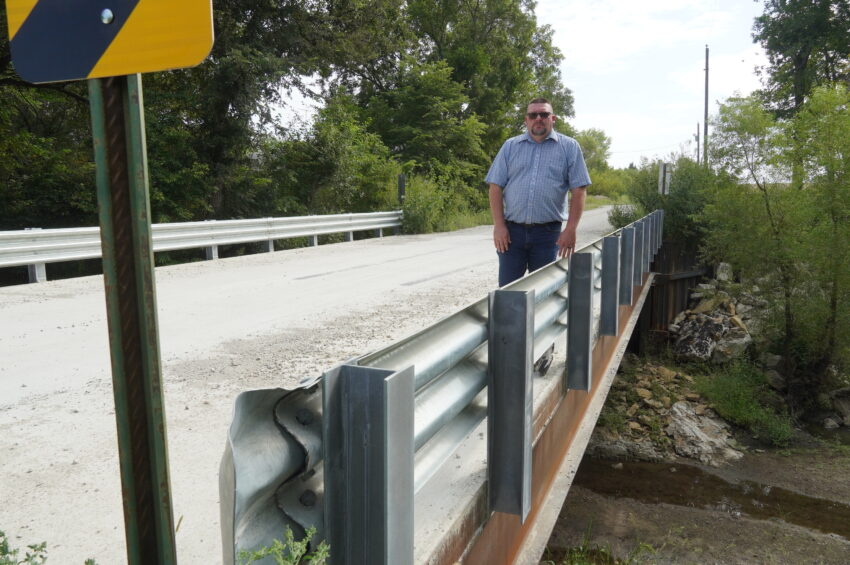Photo by Clarke Davis
Public Works Director Ben Domann stands on a newly built bridge on 170th Street west of Valley Falls. Jefferson County is a large county with a lot of bridges, most of which were declared impassable 50 years ago.
by Clarke Davis
When bridge inspections were first mandated by Congress over 50 years ago, 72% of the Jefferson County bridges were found to be incapable of carrying the legal weight limit.
That is 129 of the county’s 180 bridges. Five of those bridges were closed immediately and low-weight limits were placed on the others.
The disruption to the traffic flow on the county’s 900 miles of roads was tremendous. Marketing grain and livestock was a problem in an agricultural county as well as school buses and mail routes had to be rerouted and emergency vehicles, including fire trucks, could not cross many of the bridges.
There were 7,000 fewer residents in the county at that time, but nevertheless a high percentage were daily commuters to jobs in neighboring towns and cities.
One school district estimated it would cost the district $10,000 a year to reroute the buses.
The solution put forth by the county commissioners at that time was a $2.1 million bond issue that promised—with the aid of matching funds on a few bridges—to replace 53 of the highest priority bridges. It would have required a net increase of 3 mills.
Strangely it failed, although a majority of voters voted in favor. It was declared that a 60% approval margin was required.
The 2,966 yes to 2,082 no votes fell 63 short of that 60% and the county has been trying to play catchup for half a century.
Today, things look much brighter. Public Works Director Ben Domann, who oversees the road and bridge department, reports the county has a total of 154 bridges. A fewer number because some were replaced with large box cement culverts or low-water crossings.
Of the total, 148 are considered in fair or good condition. Four are in poor condition and two are permanently closed.
“We are now trying to get rid of most of the low-water crossings by building bridges,” Domann said.
A recent example is a new bridge on 170th west of Valley Falls that was accomplished with the aid of the Watershed Institute. The cost of the $225,000 steel and concrete bridge was split 50-50.
Norfolk Construction and Husker Steel built the bridge, but much of the work was left to the county.
“The county built the approaches to the bridge and put the rip-rap on the sides,” Domann said.
Of the approximately 10 low-water crossings that remain, Domann estimates the county will try to replace six of those as funding becomes available.
Next up will probably be the one at Rawlins Road and Fairview that was closed in 2019.
Watershed Institute Mitigation funding has provided grants to get rid of three of these crossings. The institute wants to improve streams for acquatic organisms to be able to go up stream to spawn. It also aids in streambank stabilization and restoration.
The Delware River bridge on the northeast corner of Valley Falls was reopened after the county crew jack hammered the bridge deck for three weeks and prepared it for resurfacing. It had been closed for several months after a high-water episode in 2019.
The county still has a few wooden plank bridges, some with low-weight limits. One is on 126th off Wellman Road that Domann said is used by three school districts.
The four bridges listed in poor condition are not necessarily considered high priority. They are in low-traveled areas and are not having much impact on the public or they would have been shut down, Domann said.
The two bridges considered permanently closed are located on Big Slough Creek, 2.2 miles west of Oskaloosa, and the Delaware River on the west edge of Perry. Both are iron truss bridges and would be very costly to replace, he said.
“I would never say never, but we would have to have some substantial grants to replace those,” he said.
The director continues to search for grants that will aid the county in bridge improvements and is hopeful the Bipartisan Infrastructure Law passed by Congress last fall will provide additional money for bridges in the county.
He said that money will be channeled through the Kansas Department of Transportation.
Domann oversees more than 900 miles of county roads and never knows when a weather episode or something else may eat away at his budget.
Earlier this year a rain storm in the southern portion of the county took out three 10-foot tubes that were 60 feet long and cost the county $100,000 to replace them.
The new tubes, costing $28,000 each, are reinforced corrugated metal pipe, aluminized, and won’t rust out.
“That’s the kind of vulnerability we face with over 900 miles of road,” Domann said. “One day it could just be a tree down or it could be a costly episode like that one.”
The U.S. Congress originally required the Secretary of Transportation to establish the National Bridge Inspection Standards in 1968. The original NBIS was published in 1971, creating the nation’s first nationally coordinated bridge inspection program.
Domann has been the director of the county’s public works since June 2020. He’s a 1997 graduate of Jefferson County North High School and has a degree in criminal justice from Washburn University.


